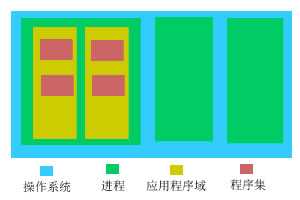标签:
大家都知道,.net写的程序,都是托管的,何为托管?就是让“其他的程序”来管理,也解析运行,什么又在这里充当“其他程序”呢?这里大体上说是CLR(通用语言运行时),这只是大体上的,准确的在底层是怎么去处理托管程序与操作系统间的关系呢?
操作系统上运行的都是进程,这进程是非托管的。现在。我们有一个Demo.exe,他是用.net写的(这里与语言无关了,因为编设成程序集后,都成为IL语言了),当然是一个托管理程序。这里的问题就是怎么把Demo.exe变成一个进程,运行在操作系统的进程中。这里就引出了应用程序域(Application Domain),应用程序域(Application Domain)是“托管理代码与非托管理代码之间的桥梁”(引自《.NET组件编程设计》)
进程,应用程序域,.net程序集(这里是Demo.exe),之间的关系可以见下图:

应用程序域(Application Domain)的引入的好处在于,如果一个程序集出现错误,不会影响到别的应用程序域(Application Domain),同时他们又是一个进程中的。
在.net中,应用程序域(Application Domain)是用AppDomain类来表示的。
AppDomain CurrentAD=AppDomain.CurrentDomain;
上面的代码实现了获取当有程序集所在的应用程序域(Application Domain)。获取当前应用程序域(Application Domain)还可以通过当前线程来得到,如下:
AppDomain CurrentAD=Threed.GetDomain();
下面再看一下在当前应用程序域(Application Domain)中创建对象:
类:
Class Class1
{
Public void FF()
{
//实现功能
}
{
AppDomain CurrentAD=Threed.GetDomain();
Class1 C1=(Class1)CurrentAD.CreateInstanceAndUnwrap(“程序集名称”,”名命空间.类名”);
C1.FF();
这个是关于当前的应用程序域(Application Domain)的操作,怎么创建一个应用程序域(Application Domain)呢?看下面
AppDomain MyAppDomain=AppDomain.CreatDomain(“MyNewAD”);
Class1 C1=(Class1)MyAppDomain.CreateInstanceAndUnwrap(“程序集名称”,”名命空间.类名”);
C1.FF();
或
AppDomain MyAppDomain=AppDomain.CreatDomain(“MyNewAD”);
IObjectHandle handle=MyAppDomain.CreateInstance “程序集名称”,”名命空间.类名”);
Class1 C1=(Class1)handle.Unwrap();
C1.FF();
后都的好处在于用C1这个对象的时候才进处理。
首先,应用程序池是IIS中的概念,而应用程序域是.net中的概念。你可以写一段程序运行在2个或更多的应用程序域上。
我在我的Vista电脑IIS7 Aps.net2.0上做了个测试。
下面是测试代码:
现在,我建立2个应用程序池AppPool1和AppPool2;
下面是返回结果:
如果你的服务器有上千个站点,你不会采用上千个应用程序池去隔离站点,那是因为,在服务器中开启了太多的进程。尽管如此,有时你需要应用程序池。应用程序池的好处在于你可以配置应用程序池的标识。同样你可以更多灵活的方式去回收应用程序池。而IIS没有提供配置参数去回收应用程序池。
A question was asked on a forum that I frequent which I thought was worth writting a blog about.
Q: What is the difference between an application and an Appdomain? I understand from my research so far that an Appdomain is a container within which ASPX runs and that Apppool is a process that starts the w3wp.exe worker process within which ASP applications run.
A: That‘s a good question. Here are some key differences:
标签:
原文地址:http://www.cnblogs.com/CrabMan/p/5167288.html